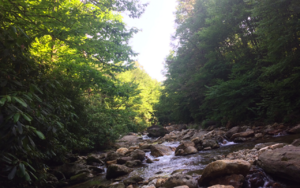Pigeon River (Tennessee–North Carolina) facts for kids
Quick facts for kids Pigeon River |
|
|---|---|

The confluence of the Pigeon River and Big Creek in Waterville, North Carolina. The power plant is in the background.
|
|

Pigeon River watershed (Interactive map)
|
|
| Country | United States |
| State | North Carolina, Tennessee |
| Physical characteristics | |
| Main source | West Fork Pigeon River below Mount Hardy in Haywood County, North Carolina 5,320 ft (1,620 m) 35°18′11″N 82°55′05″W / 35.30306°N 82.91806°W |
| 2nd source | East Fork Pigeon River below South Spring Top in Haywood County, North Carolina 4,190 ft (1,280 m) 35°19′37″N 82°49′47″W / 35.32694°N 82.82972°W |
| River mouth | French Broad River Irish Bottoms in Cocke County, Tennessee 1,001 ft (305 m) 36°01′28″N 83°11′47″W / 36.02444°N 83.19639°W |
| Length | 70 mi (110 km) |
| Basin features | |
| Basin size | 704 sq mi (1,820 km2) |
The Pigeon River flows through Western North Carolina and East Tennessee. It starts near Canton, North Carolina, is held back by the Walters Dam, then enters Tennessee. Finally, it flows into the French Broad River near Newport, Tennessee. This river runs through the Pisgah National Forest and the Cherokee National Forest. It also drains a large part of the northeastern Great Smoky Mountains National Park.
The river got its name from the passenger pigeon. This bird is now extinct, but its migration path used to include the river valley in North Carolina.
Contents
Where Does the Pigeon River Flow?
The Pigeon River begins in southeastern Haywood County, North Carolina. It generally flows northwest for most of its journey. Near Pressley Mountain, it turns northeast for about four miles. In the town of Canton, it turns north. A paper mill there once used the river's water.
After Canton, the river turns west for about five miles. Then it goes back to its northwest direction near Clyde. From Canton, the Pigeon River flows mostly next to Interstate 40 for many miles.
Walters Dam and Waterville Lake
The river is blocked by the Walters Dam, which was built by Progress Energy. This dam creates a long, narrow body of water called Waterville Lake. The river then crosses into Tennessee just after the village of Waterville. It continues alongside I-40 through Hartford to Newport. In Newport, I-40 turns west, and the Pigeon River flows north into the French Broad River.
History of the Pigeon River
Building the Walters Dam
Construction on the Pigeon River dam began in 1927 and finished in 1930 . The company Carolina Power & Light started the project. Its partner, Phoenix Electric Co., completed it. The concrete dam is 180 ft (55 m) high and 800 ft (240 m) long. The power plant, which you can see from I-40, is actually 6.2 miles (10.0 km) away from the dam. A tunnel, also 6.2 miles (10.0 km) long, connects the dam to the power plant.
Floods of 2004
In September 2004, a series of storms from Hurricanes Frances and Ivan caused huge floods. These floods changed the river a lot. The heavy rains lasted for days, and the flooding was very bad. Parts of Canton and Clyde were completely underwater. Both towns had a lot of damage.
Further upstream, the water levels reached record highs. A section of Interstate 40 even collapsed into the river gorge. This happened because the strong floodwaters washed away trees and the soil holding them. The side of the highway gave way, and a guardrail was left hanging.
River Pollution Concerns
A large paper mill in Canton, once owned by Champion International Paper and later by Blue Ridge Paper Company, was a main source of pollution in the Pigeon River. This pollution included substances like dioxin and tiny particles.
The pollution in the river became a topic during the 1988 Presidential election. Al Gore was running for president for the first time. Newsweek magazine reported that North Carolina Senator Terry Sanford and Congressman Jamie Clarke asked Gore to be less strict about the paper mill's wastewater going into the river. According to Newsweek, Gore agreed and wrote to the United States Environmental Protection Agency (EPA) to oppose stricter pollution rules. This issue came up again during the 2000 Presidential election.
Fun on the Pigeon River
Recreational rafting is very popular on two parts of the river: the Upper section and the Lower section. Both of these areas are found in Hartford, Tennessee.
The Upper section starts at the powerhouse, right on the North Carolina/Tennessee border. This part has exciting whitewater rapids that can be up to Class III+. The Lower section has "more modest" waves, which means they are less intense.
See also
 In Spanish: Río Pigeon para niños
In Spanish: Río Pigeon para niños


